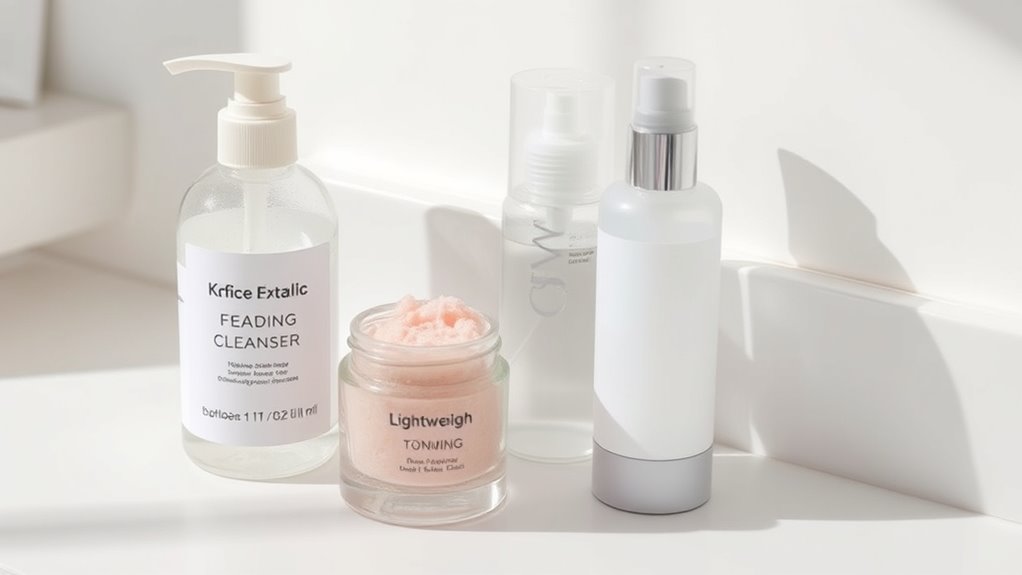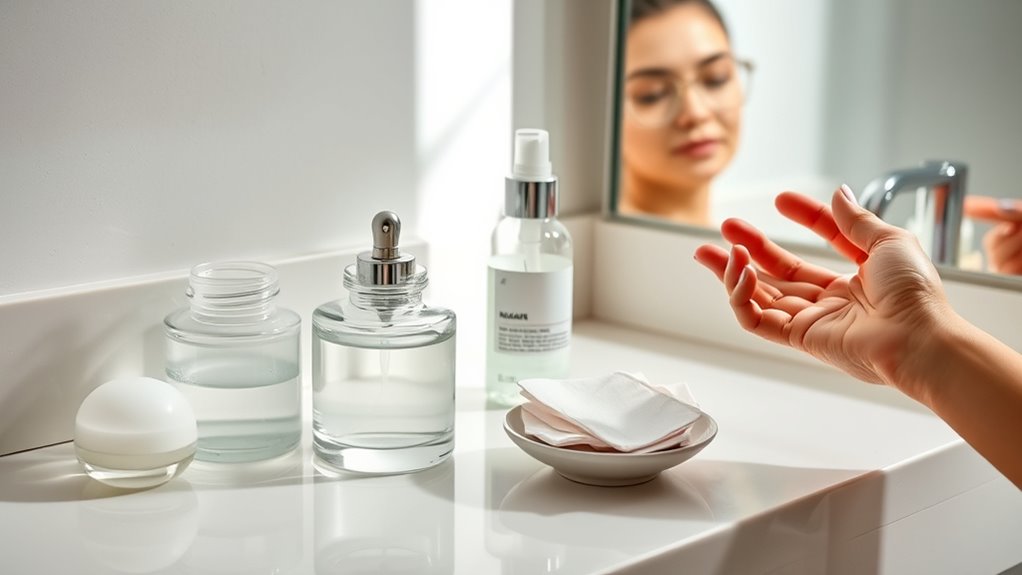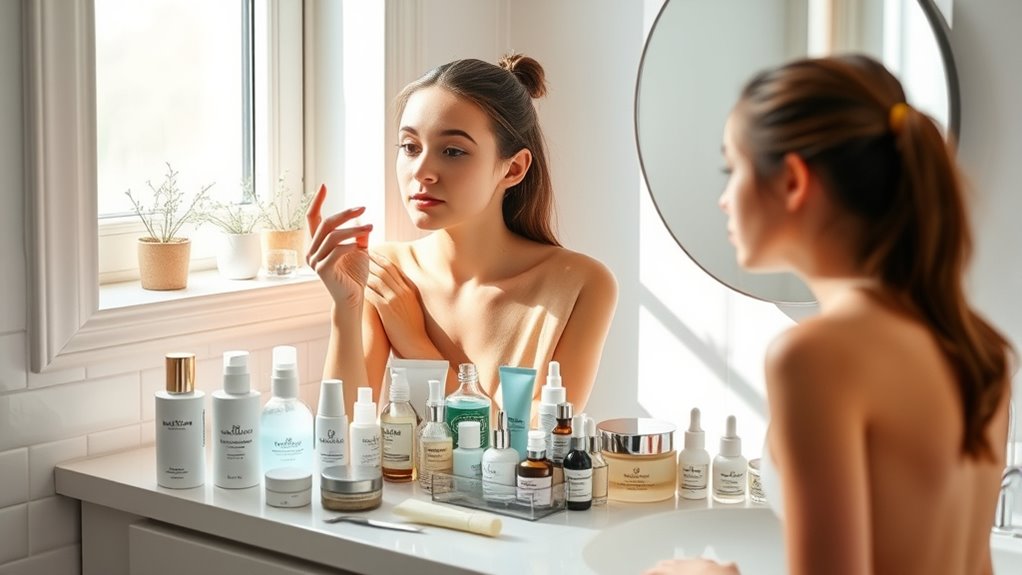To build a simple skincare routine, start by identifying your skin type—oily, dry, sensitive, or combination—so you can choose the right products. Begin with basic steps: cleanse twice if needed, tone to balance your skin, apply moisturizer, and finish with sunscreen daily. Be consistent and patient, adjusting your routine seasonally or as your skin changes. Keep learning tips and common mistakes to guarantee your skin stays healthy and balanced.
Key Takeaways
- Identify your skin type and concerns to select suitable products and ingredients.
- Start with a simple routine: cleanse, tone, and moisturize daily for consistent results.
- Always apply sunscreen as the final step to protect your skin from UV damage.
- Layer products properly, applying thin, even coats and including targeted treatments as needed.
- Be patient and adjust your routine seasonally and over time to accommodate skin changes.
Understanding Your Skin Type

Have you ever wondered why some skincare products work better for you than others? It all comes down to understanding your skin type. Your skin’s hydration levels play a vital role—dry skin needs more moisture, while oily skin may require lightweight, oil-free products. Pore size also matters; larger pores can indicate excess oil or dead skin buildup, affecting how products absorb. Recognizing whether your skin is oily, dry, sensitive, or combination helps you choose the right ingredients and avoid irritation. Understanding your skin’s characteristics also helps you prevent common issues like breakouts or dryness, ensuring your skincare efforts are effective and comfortable.
The Basic Steps of a Skincare Routine

Start your routine with effective cleansing to remove dirt and excess oil. Follow with toning to balance your skin’s pH and prepare it for moisturizer. Finish by applying a proper moisturizer to keep your skin hydrated and protected throughout the day. Incorporating consistent messaging can also help you stick to your routine and see better results.
Cleansing Methods Effectiveness
Cleansing is an essential step in any skincare routine because it removes dirt, oil, and impurities that can clog pores and cause breakouts. To maximize effectiveness, consider double cleansing—starting with an oil-based cleanser to break down makeup, sunscreen, and excess sebum, followed by a water-based cleanser to eliminate residual dirt. Oil-based cleansers are especially good for removing stubborn impurities without stripping your skin’s natural oils. This method ensures a thorough cleanse, leaving your skin refreshed and prepared for subsequent steps. Choosing the right cleansing method based on your skin type helps prevent irritation and over-drying. Incorporating proper cleansing techniques can further enhance skin health and prevent irritation. Consistent, proper cleansing plays a critical role in maintaining clear, healthy skin and setting a strong foundation for the rest of your skincare routine.
Toning and Balancing
After thoroughly cleansing your skin, applying a toner helps restore balance and prepare it for subsequent treatments. A good toner refreshes your skin, tightens pores, and sets the stage for better absorption of skincare products. Look for toners with natural ingredients like witch hazel, rose water, or chamomile to soothe and calm your skin. You can also try DIY treatments, such as mixing apple cider vinegar with water for a natural toner. To incorporate toning into your routine, follow these steps:
- Apply toner with a cotton pad or your fingertips, gently patting it onto your face.
- Focus on areas prone to oiliness or breakouts.
- Let it absorb fully before moving on to moisturizers or treatments.
- Choosing a toner with color accuracy and proper calibration can enhance your overall skincare routine by ensuring the product’s effectiveness.
Moisturizing Techniques Proper
Are you applying moisturizer correctly to maximize its benefits? Proper moisturizing techniques ensure your skin gets the hydration boost it needs. Start by gently patting your face dry, then take a small amount of moisturizer. Use layering techniques by applying thin, even layers, starting with lighter products and moving to thicker ones. This helps lock in moisture effectively. Don’t forget to cover all areas, including your neck. Pat the moisturizer into your skin instead of rubbing, promoting better absorption. If your skin feels dry or tight later in the day, consider adding a second layer. Proper moisturizing not only keeps your skin hydrated but also creates a smooth base for makeup and other products, making your routine more efficient and effective. Incorporating skincare techniques ensures your hydration efforts are as effective as possible.
Choosing the Right Products for Your Skin

When selecting skincare products, it’s vital to match them to your skin type for the best results. Look for ingredients you can understand and trust, as transparency helps you avoid potential irritants. By focusing on compatibility and ingredient clarity, you’ll build a routine that truly works for you.
Skin Type Compatibility
Understanding your skin type is essential for selecting products that work effectively without causing irritation or breakouts. When checking ingredient labels, look for ingredients suited to your skin’s needs, whether it’s oily, dry, or sensitive. Knowing your skin sensitivity helps you avoid harsh ingredients that can trigger reactions. Additionally, being aware of AI’s role in skincare can guide you towards innovative products and personalized recommendations. Here’s how to choose products based on your skin type:
- For oily skin, opt for oil-free, mattifying formulas that control excess sebum.
- For dry skin, select hydrating, nourishing products with moisturizing ingredients.
- For sensitive skin, choose gentle, fragrance-free options designed to minimize irritation.
Matching products to your skin type ensures they’ll be effective and comfortable, helping you build a routine that promotes healthy, balanced skin.
Ingredient Transparency
Choosing skincare products with transparent ingredients allows you to make informed decisions that suit your skin’s unique needs. Ingredient transparency means you can see exactly what’s in your products, helping you avoid harmful or unnecessary ingredients. When you prioritize ingredient safety, you reduce the risk of irritation or adverse reactions. Reading labels carefully lets you identify potential allergens or irritants, especially if you have sensitive skin. Transparent labels also help you choose products with beneficial ingredients tailored to your skin concerns. By understanding ingredient lists, you gain control over what you’re applying to your skin, ensuring each product aligns with your goals. Additionally, being aware of product materials can improve overall skin health and longevity. Ultimately, ingredient transparency empowers you to build a skincare routine that’s safe, effective, and suited specifically to your skin’s needs.
The Importance of Consistency and Patience

Building healthy skin habits requires more than just following a skincare routine; it demands consistency and patience. When you stick to your routine daily, your skin gradually adapts, and you’ll see results over time. Remember, product layering should be gentle, respecting ingredient sensitivities to avoid irritation. Incorporating nutrient-rich ingredients can further enhance your skin’s health and appearance.
Consistent, gentle skincare over time yields healthy, resilient skin and visible improvements.
To stay on track:
- Be patient—visible improvements can take weeks.
- Maintain regularity—skipping days delays progress.
- Listen to your skin—adjust products thoughtfully based on how it responds.
Consistency helps your skin build resilience and clarity, especially when introducing new ingredients or routines. Patience ensures you don’t get discouraged if results aren’t immediate. Stick with it, and your skin will thank you.
Incorporating Sunscreen Into Your Daily Routine

Incorporating sunscreen into your daily routine is essential for protecting your skin from harmful UV rays and preventing premature aging. Start each morning with proper sunscreen application, making sure to cover all exposed skin evenly. Choose an SPF that suits your skin type and daily exposure; generally, an SPF 30 or higher offers good protection. Don’t forget to reapply every two hours if you’re outdoors or sweating. Applying sunscreen before makeup ensures a smooth, even finish without sacrificing protection. Make it a habit to include sunscreen as a final step in your skincare routine, just after moisturizer. Using sound design techniques such as consistent application and layering can enhance your skincare effectiveness and help you maintain a healthier, more youthful appearance over time.
Tips for Adjusting Your Routine as Your Skin Changes

As your skin changes over time, it’s important to adapt your skincare routine to meet its evolving needs. Seasonal changes can affect how your skin responds, so adjusting products is key.
As your skin evolves, adjust your skincare routine to stay radiant year-round.
A great way to enhance your routine is by incorporating glycolic acid products, which can improve skin texture and radiance.
- Monitor your skin’s response regularly and note any new sensitivities or dryness.
- Adapt products by switching to richer moisturizers in winter and lighter formulas in summer.
- Keep an eye on ingredients—what worked before might need replacing as your skin’s needs shift.
Common Mistakes to Avoid When Starting Out

Starting your skincare journey can be exciting, but it’s easy to make mistakes that hinder your progress. One common error is ignoring seasonal adjustments; your skin needs different care in winter versus summer. Using heavy creams in summer can clog pores, while lighter products in winter might not provide enough hydration. Another mistake is overlooking ingredient sensitivity. Jumping into strong products without patch testing can cause irritation or breakouts. Avoid overloading your routine with too many products at once, which can overwhelm your skin and cause adverse reactions. Stick to simple, targeted steps and introduce new ingredients gradually. Listening to your skin’s signals and adjusting your routine accordingly helps prevent setbacks and keeps your skin healthy and balanced as seasons change.
Frequently Asked Questions
How Often Should I Update My Skincare Routine?
You should update your skincare routine every few months to account for product longevity and changing skin needs. Pay attention to how your skin responds and look for signs that products may no longer be effective or suitable. Routine adjustments are key to maintaining healthy skin, so don’t hesitate to switch products or tweak your regimen as seasons change or your skin evolves. Regular updates keep your routine fresh and effective.
Can I Mix Different Skincare Products Safely?
You can mix different skincare products safely if you pay attention to product compatibility and ingredient mixing. Always check labels for potential interactions, especially with active ingredients like retinol or acids. Test new combinations on a small skin patch first to avoid reactions. If unsure, consult a dermatologist. Combining products thoughtfully guarantees you maximize benefits without irritating your skin, making your routine both effective and safe.
What Should I Do if I Experience Skin Irritation?
When your skin throws a tantrum, it’s like a fire alarm going off. If you experience skin irritation, especially with sensitive skin or ingredient allergies, stop using new products immediately. Gently cleanse your face and apply a soothing, fragrance-free moisturizer. Avoid harsh ingredients and consider consulting a dermatologist. Remember, listening to your skin is key—treat it kindly and give it time to heal.
Are Natural or DIY Products Better for Beginners?
When choosing between natural ingredients and DIY skincare, think about your skin’s needs. DIY skincare can be fun and cost-effective, but it might lack the consistency and safety of store-bought products made with natural ingredients. For beginners, natural products from reputable brands are usually safer because they’re tested and formulated properly. Stick with gentle, natural ingredients to reduce the risk of irritation and build your skincare confidence gradually.
How Do I Identify Hidden Ingredients in Skincare Products?
Did you know over 80% of skincare products contain ingredients that aren’t clearly labeled? To spot hidden ingredients, always read ingredient labels carefully, looking out for unfamiliar or long chemical names. If you have ingredient sensitivities, research each ingredient’s effects. Trust transparent brands that list all ingredients clearly. Being vigilant helps you avoid unwanted reactions and ensures your skin only gets what it truly needs.
Conclusion
Starting a skincare routine might seem overwhelming, but remember, it’s about taking small, consistent steps. Even if you’re busy or unsure where to begin, simple daily habits make a big difference over time. Don’t worry about doing everything perfectly—your skin will thank you for sticking with it. With patience and the right products, you’ll see improvements and feel more confident in your skin each day. Just start, and keep going—you’ve got this!









